Jiaqi Tang
ACE: Attribution-Controlled Knowledge Editing for Multi-hop Factual Recall
Oct 09, 2025


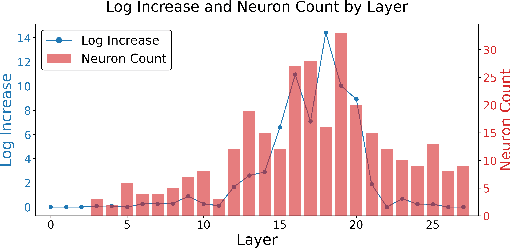
Abstract:Large Language Models (LLMs) require efficient knowledge editing (KE) to update factual information, yet existing methods exhibit significant performance decay in multi-hop factual recall. This failure is particularly acute when edits involve intermediate implicit subjects within reasoning chains. Through causal analysis, we reveal that this limitation stems from an oversight of how chained knowledge is dynamically represented and utilized at the neuron level. We discover that during multi hop reasoning, implicit subjects function as query neurons, which sequentially activate corresponding value neurons across transformer layers to accumulate information toward the final answer, a dynamic prior KE work has overlooked. Guided by this insight, we propose ACE: Attribution-Controlled Knowledge Editing for Multi-hop Factual Recall, a framework that leverages neuron-level attribution to identify and edit these critical query-value (Q-V) pathways. ACE provides a mechanistically grounded solution for multi-hop KE, empirically outperforming state-of-the-art methods by 9.44% on GPT-J and 37.46% on Qwen3-8B. Our analysis further reveals more fine-grained activation patterns in Qwen3 and demonstrates that the semantic interpretability of value neurons is orchestrated by query-driven accumulation. These findings establish a new pathway for advancing KE capabilities based on the principled understanding of internal reasoning mechanisms.
LPO: Towards Accurate GUI Agent Interaction via Location Preference Optimization
Jun 11, 2025

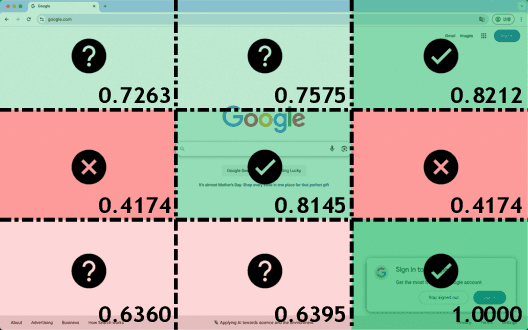
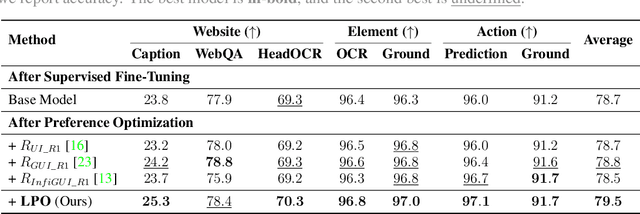
Abstract:The advent of autonomous agents is transforming interactions with Graphical User Interfaces (GUIs) by employing natural language as a powerful intermediary. Despite the predominance of Supervised Fine-Tuning (SFT) methods in current GUI agents for achieving spatial localization, these methods face substantial challenges due to their limited capacity to accurately perceive positional data. Existing strategies, such as reinforcement learning, often fail to assess positional accuracy effectively, thereby restricting their utility. In response, we introduce Location Preference Optimization (LPO), a novel approach that leverages locational data to optimize interaction preferences. LPO uses information entropy to predict interaction positions by focusing on zones rich in information. Besides, it further introduces a dynamic location reward function based on physical distance, reflecting the varying importance of interaction positions. Supported by Group Relative Preference Optimization (GRPO), LPO facilitates an extensive exploration of GUI environments and significantly enhances interaction precision. Comprehensive experiments demonstrate LPO's superior performance, achieving SOTA results across both offline benchmarks and real-world online evaluations. Our code will be made publicly available soon, at https://github.com/AIDC-AI/LPO.
Sage Deer: A Super-Aligned Driving Generalist Is Your Copilot
May 15, 2025Abstract:The intelligent driving cockpit, an important part of intelligent driving, needs to match different users' comfort, interaction, and safety needs. This paper aims to build a Super-Aligned and GEneralist DRiving agent, SAGE DeeR. Sage Deer achieves three highlights: (1) Super alignment: It achieves different reactions according to different people's preferences and biases. (2) Generalist: It can understand the multi-view and multi-mode inputs to reason the user's physiological indicators, facial emotions, hand movements, body movements, driving scenarios, and behavioral decisions. (3) Self-Eliciting: It can elicit implicit thought chains in the language space to further increase generalist and super-aligned abilities. Besides, we collected multiple data sets and built a large-scale benchmark. This benchmark measures the deer's perceptual decision-making ability and the super alignment's accuracy.
Locating and Mitigating Gradient Conflicts in Point Cloud Domain Adaptation via Saliency Map Skewness
Apr 22, 2025Abstract:Object classification models utilizing point cloud data are fundamental for 3D media understanding, yet they often struggle with unseen or out-of-distribution (OOD) scenarios. Existing point cloud unsupervised domain adaptation (UDA) methods typically employ a multi-task learning (MTL) framework that combines primary classification tasks with auxiliary self-supervision tasks to bridge the gap between cross-domain feature distributions. However, our further experiments demonstrate that not all gradients from self-supervision tasks are beneficial and some may negatively impact the classification performance. In this paper, we propose a novel solution, termed Saliency Map-based Data Sampling Block (SM-DSB), to mitigate these gradient conflicts. Specifically, our method designs a new scoring mechanism based on the skewness of 3D saliency maps to estimate gradient conflicts without requiring target labels. Leveraging this, we develop a sample selection strategy that dynamically filters out samples whose self-supervision gradients are not beneficial for the classification. Our approach is scalable, introducing modest computational overhead, and can be integrated into all the point cloud UDA MTL frameworks. Extensive evaluations demonstrate that our method outperforms state-of-the-art approaches. In addition, we provide a new perspective on understanding the UDA problem through back-propagation analysis.
SURGEON: Memory-Adaptive Fully Test-Time Adaptation via Dynamic Activation Sparsity
Mar 26, 2025Abstract:Despite the growing integration of deep models into mobile terminals, the accuracy of these models declines significantly due to various deployment interferences. Test-time adaptation (TTA) has emerged to improve the performance of deep models by adapting them to unlabeled target data online. Yet, the significant memory cost, particularly in resource-constrained terminals, impedes the effective deployment of most backward-propagation-based TTA methods. To tackle memory constraints, we introduce SURGEON, a method that substantially reduces memory cost while preserving comparable accuracy improvements during fully test-time adaptation (FTTA) without relying on specific network architectures or modifications to the original training procedure. Specifically, we propose a novel dynamic activation sparsity strategy that directly prunes activations at layer-specific dynamic ratios during adaptation, allowing for flexible control of learning ability and memory cost in a data-sensitive manner. Among this, two metrics, Gradient Importance and Layer Activation Memory, are considered to determine the layer-wise pruning ratios, reflecting accuracy contribution and memory efficiency, respectively. Experimentally, our method surpasses the baselines by not only reducing memory usage but also achieving superior accuracy, delivering SOTA performance across diverse datasets, architectures, and tasks.
CalliReader: Contextualizing Chinese Calligraphy via an Embedding-Aligned Vision-Language Model
Mar 09, 2025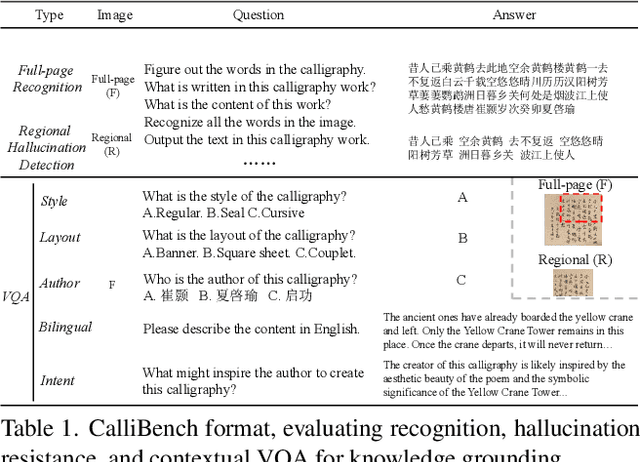
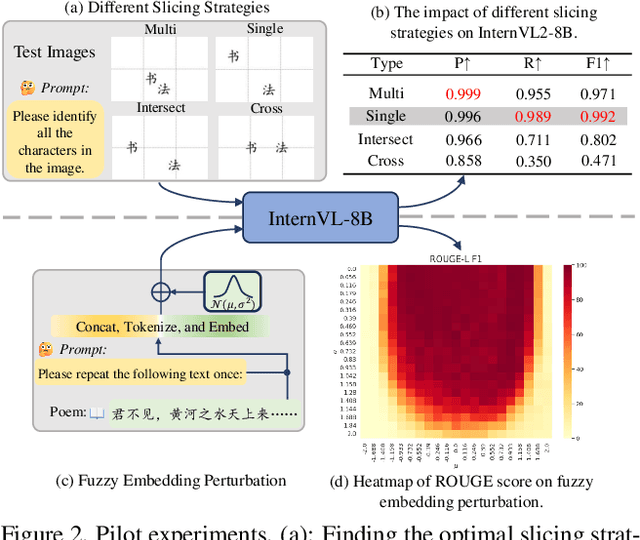
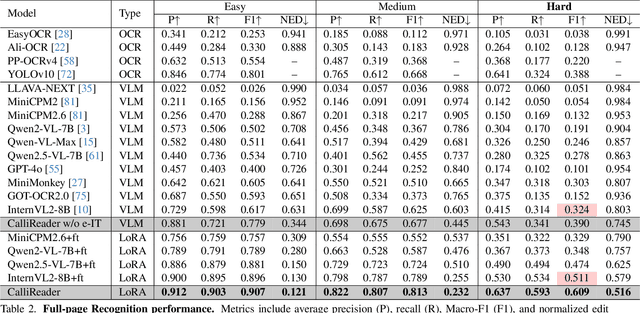
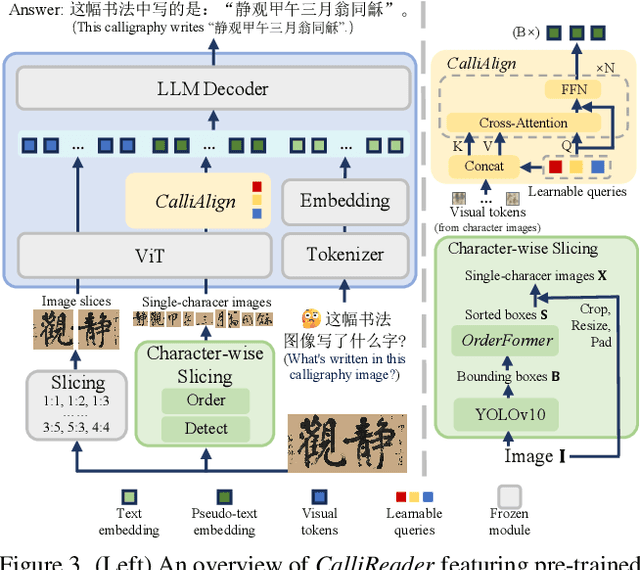
Abstract:Chinese calligraphy, a UNESCO Heritage, remains computationally challenging due to visual ambiguity and cultural complexity. Existing AI systems fail to contextualize their intricate scripts, because of limited annotated data and poor visual-semantic alignment. We propose CalliReader, a vision-language model (VLM) that solves the Chinese Calligraphy Contextualization (CC$^2$) problem through three innovations: (1) character-wise slicing for precise character extraction and sorting, (2) CalliAlign for visual-text token compression and alignment, (3) embedding instruction tuning (e-IT) for improving alignment and addressing data scarcity. We also build CalliBench, the first benchmark for full-page calligraphic contextualization, addressing three critical issues in previous OCR and VQA approaches: fragmented context, shallow reasoning, and hallucination. Extensive experiments including user studies have been conducted to verify our CalliReader's \textbf{superiority to other state-of-the-art methods and even human professionals in page-level calligraphy recognition and interpretation}, achieving higher accuracy while reducing hallucination. Comparisons with reasoning models highlight the importance of accurate recognition as a prerequisite for reliable comprehension. Quantitative analyses validate CalliReader's efficiency; evaluations on document and real-world benchmarks confirm its robust generalization ability.
Activation-aware Probe-Query: Effective Key-Value Retrieval for Long-Context LLMs Inference
Feb 19, 2025Abstract:Recent advances in large language models (LLMs) have showcased exceptional performance in long-context tasks, while facing significant inference efficiency challenges with limited GPU memory. Existing solutions first proposed the sliding-window approach to accumulate a set of historical \textbf{key-value} (KV) pairs for reuse, then further improvements selectively retain its subsets at each step. However, due to the sparse attention distribution across a long context, it is hard to identify and recall relevant KV pairs, as the attention is distracted by massive candidate pairs. Additionally, we found it promising to select representative tokens as probe-Query in each sliding window to effectively represent the entire context, which is an approach overlooked by existing methods. Thus, we propose \textbf{ActQKV}, a training-free, \textbf{Act}ivation-aware approach that dynamically determines probe-\textbf{Q}uery and leverages it to retrieve the relevant \textbf{KV} pairs for inference. Specifically, ActQKV monitors a token-level indicator, Activation Bias, within each context window, enabling the proper construction of probe-Query for retrieval at pre-filling stage. To accurately recall the relevant KV pairs and minimize the irrelevant ones, we design a dynamic KV cut-off mechanism guided by information density across layers at the decoding stage. Experiments on the Long-Bench and $\infty$ Benchmarks demonstrate its state-of-the-art performance with competitive inference quality and resource efficiency.
Adaptivity and Convergence of Probability Flow ODEs in Diffusion Generative Models
Jan 31, 2025Abstract:Score-based generative models, which transform noise into data by learning to reverse a diffusion process, have become a cornerstone of modern generative AI. This paper contributes to establishing theoretical guarantees for the probability flow ODE, a widely used diffusion-based sampler known for its practical efficiency. While a number of prior works address its general convergence theory, it remains unclear whether the probability flow ODE sampler can adapt to the low-dimensional structures commonly present in natural image data. We demonstrate that, with accurate score function estimation, the probability flow ODE sampler achieves a convergence rate of $O(k/T)$ in total variation distance (ignoring logarithmic factors), where $k$ is the intrinsic dimension of the target distribution and $T$ is the number of iterations. This dimension-free convergence rate improves upon existing results that scale with the typically much larger ambient dimension, highlighting the ability of the probability flow ODE sampler to exploit intrinsic low-dimensional structures in the target distribution for faster sampling.
AdaShadow: Responsive Test-time Model Adaptation in Non-stationary Mobile Environments
Oct 10, 2024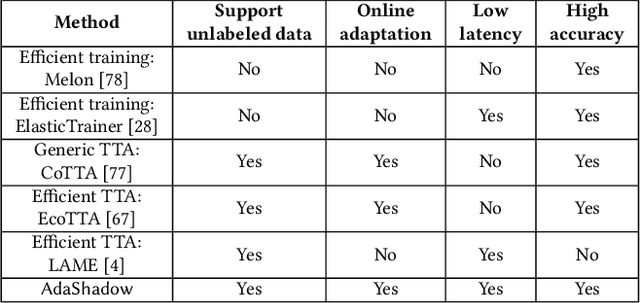


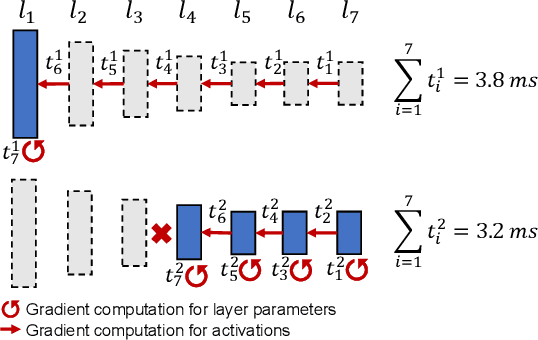
Abstract:On-device adapting to continual, unpredictable domain shifts is essential for mobile applications like autonomous driving and augmented reality to deliver seamless user experiences in evolving environments. Test-time adaptation (TTA) emerges as a promising solution by tuning model parameters with unlabeled live data immediately before prediction. However, TTA's unique forward-backward-reforward pipeline notably increases the latency over standard inference, undermining the responsiveness in time-sensitive mobile applications. This paper presents AdaShadow, a responsive test-time adaptation framework for non-stationary mobile data distribution and resource dynamics via selective updates of adaptation-critical layers. Although the tactic is recognized in generic on-device training, TTA's unsupervised and online context presents unique challenges in estimating layer importance and latency, as well as scheduling the optimal layer update plan. AdaShadow addresses these challenges with a backpropagation-free assessor to rapidly identify critical layers, a unit-based runtime predictor to account for resource dynamics in latency estimation, and an online scheduler for prompt layer update planning. Also, AdaShadow incorporates a memory I/O-aware computation reuse scheme to further reduce latency in the reforward pass. Results show that AdaShadow achieves the best accuracy-latency balance under continual shifts. At low memory and energy costs, Adashadow provides a 2x to 3.5x speedup (ms-level) over state-of-the-art TTA methods with comparable accuracy and a 14.8% to 25.4% accuracy boost over efficient supervised methods with similar latency.
* This paper is accepted by SenSys 2024. Copyright may be transferred without notice
Hawk: Learning to Understand Open-World Video Anomalies
May 27, 2024



Abstract:Video Anomaly Detection (VAD) systems can autonomously monitor and identify disturbances, reducing the need for manual labor and associated costs. However, current VAD systems are often limited by their superficial semantic understanding of scenes and minimal user interaction. Additionally, the prevalent data scarcity in existing datasets restricts their applicability in open-world scenarios. In this paper, we introduce Hawk, a novel framework that leverages interactive large Visual Language Models (VLM) to interpret video anomalies precisely. Recognizing the difference in motion information between abnormal and normal videos, Hawk explicitly integrates motion modality to enhance anomaly identification. To reinforce motion attention, we construct an auxiliary consistency loss within the motion and video space, guiding the video branch to focus on the motion modality. Moreover, to improve the interpretation of motion-to-language, we establish a clear supervisory relationship between motion and its linguistic representation. Furthermore, we have annotated over 8,000 anomaly videos with language descriptions, enabling effective training across diverse open-world scenarios, and also created 8,000 question-answering pairs for users' open-world questions. The final results demonstrate that Hawk achieves SOTA performance, surpassing existing baselines in both video description generation and question-answering. Our codes/dataset/demo will be released at https://github.com/jqtangust/hawk.
 Add to Chrome
Add to Chrome Add to Firefox
Add to Firefox Add to Edge
Add to Edge